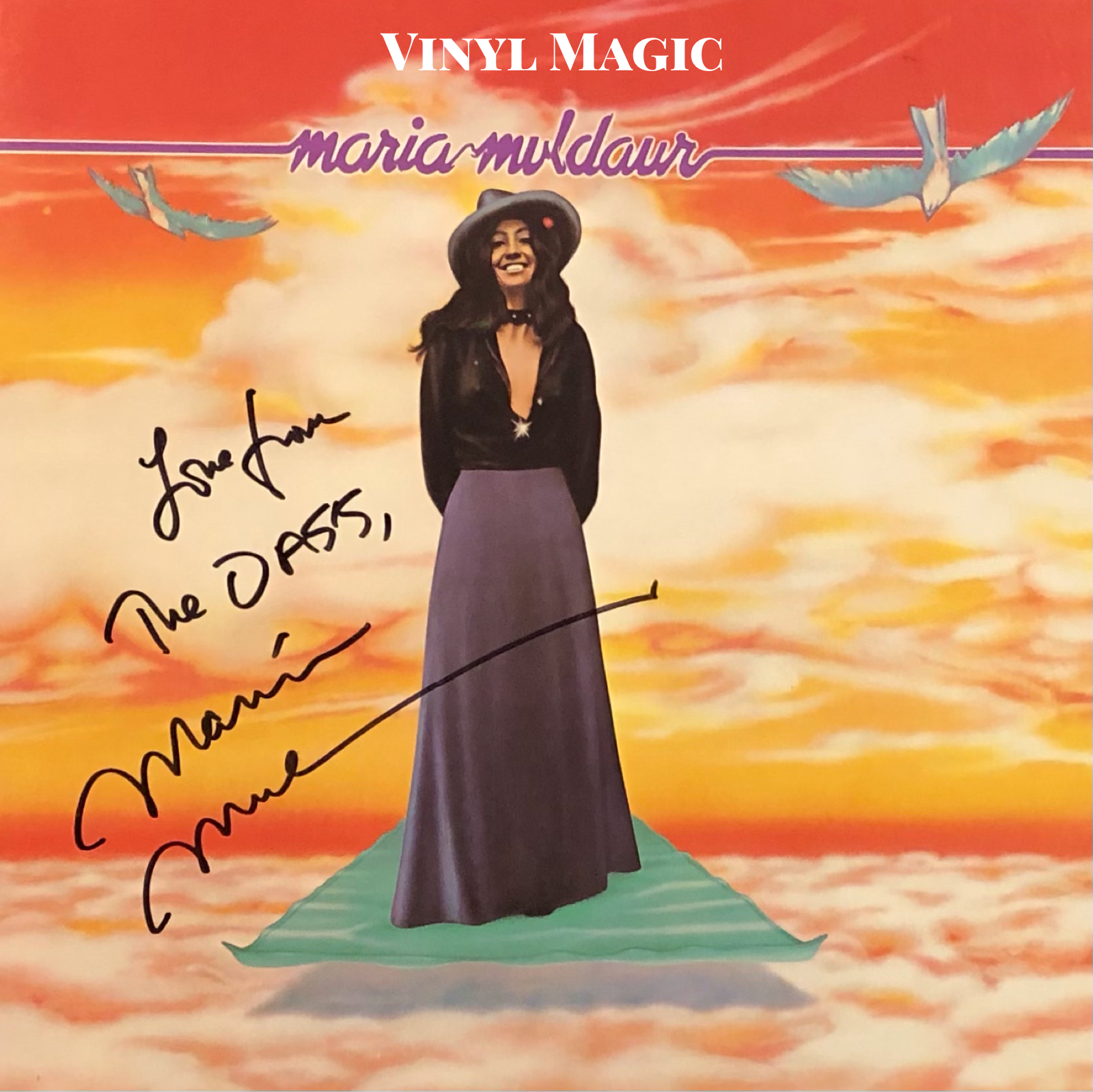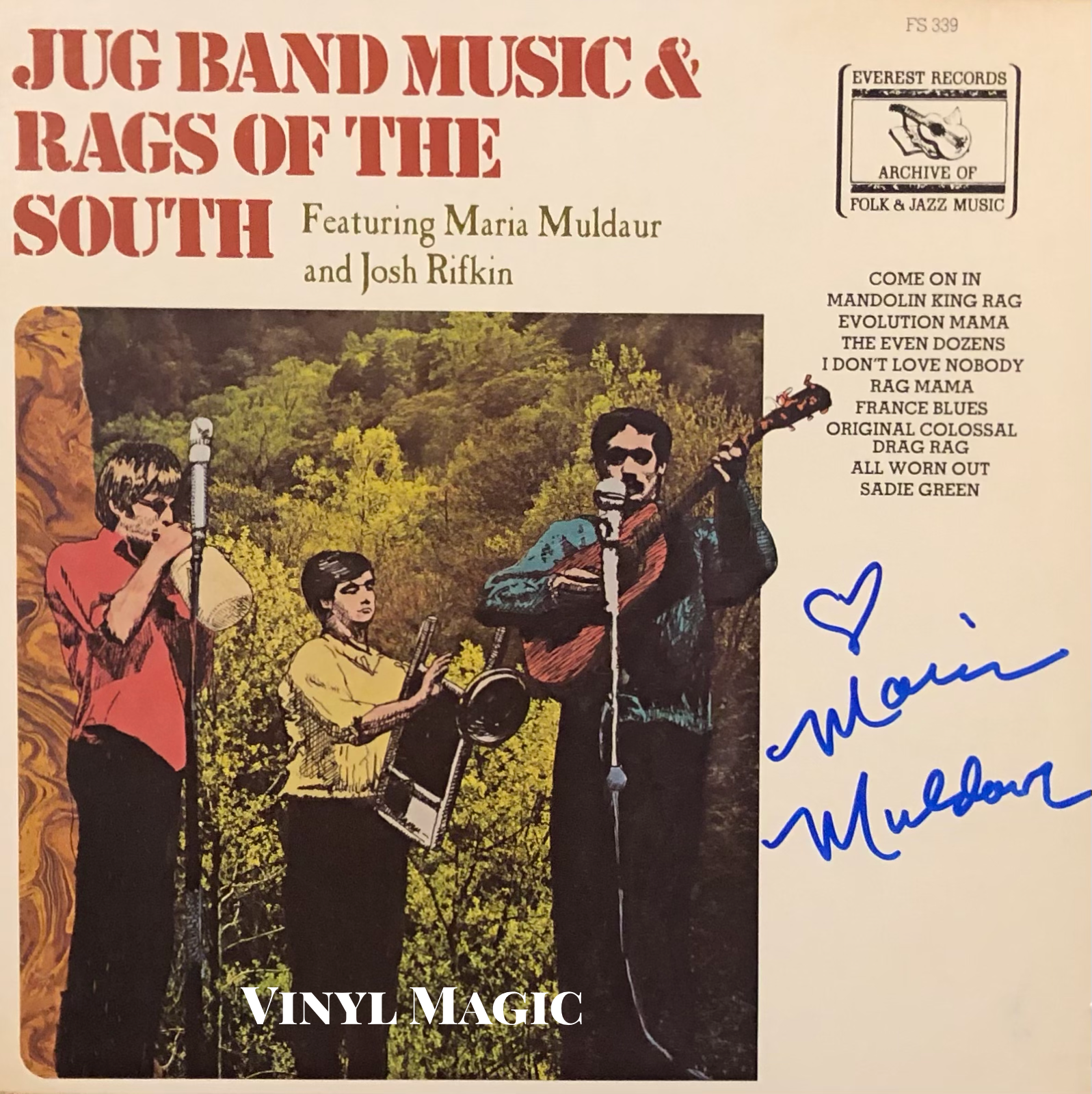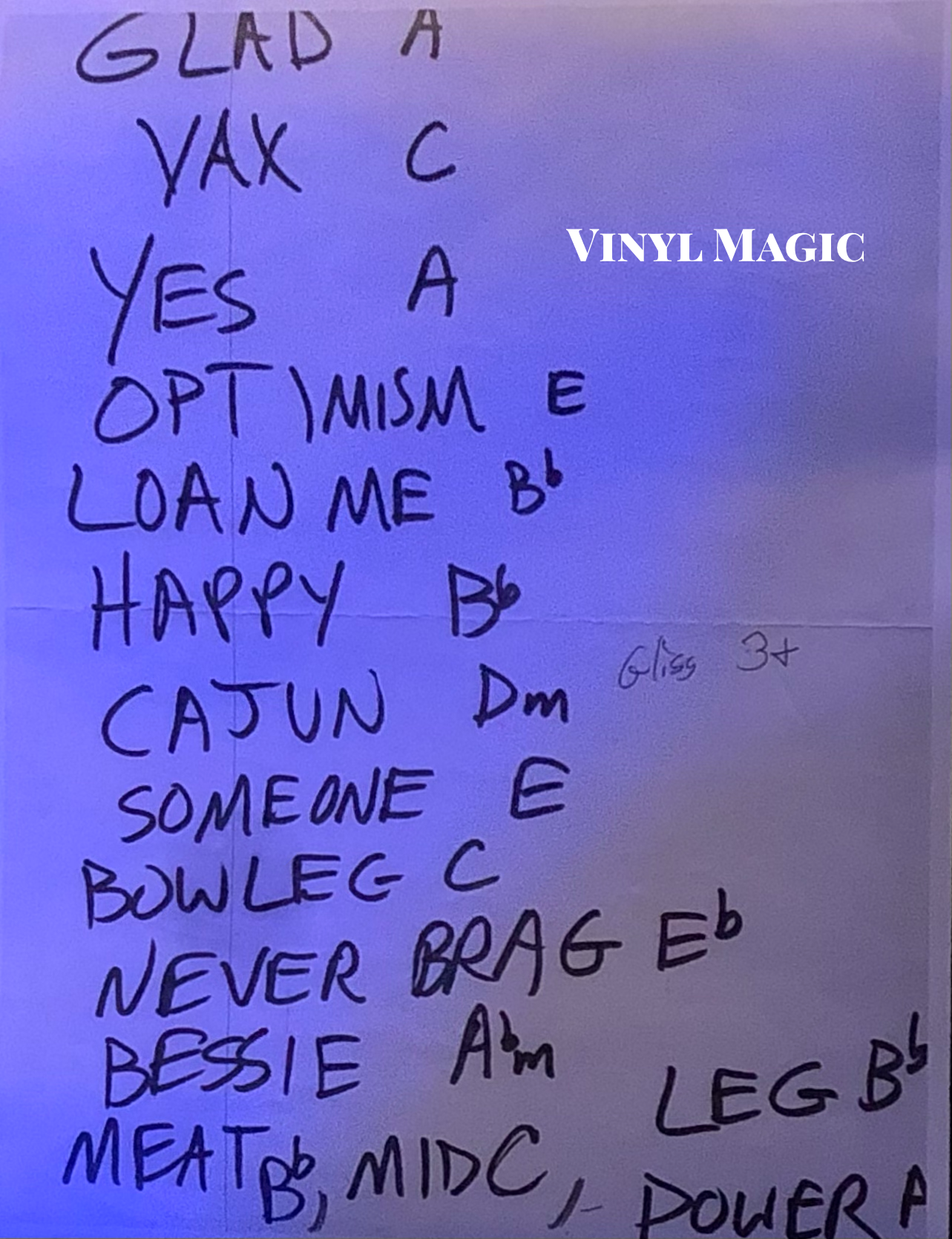Maria Muldaur and Me…
I could tune in a little country music station from Newark, New Jersey. Aunt Katie used to listen to this station all the time, so at age five I was listening to Kitty Wells, Hank Williams, Hank Snow, Hank Thompson - lots of guys named Hank. Ernest Tubb, people like that, you know, Bob Wills and the Texas Playboys. The first song I remember singing is "It Wasn't God Who Made Honky Tonk Angels" at age five. I didn't have a major plan to become a singer, I just started being a singer.
Maria Muldaur
Maria Muldaur (1973) signed by Maria Love From The Oasis
They brought Doc Watson and The Watson Family up to a concert. I was, of course, floored by Doc Watson’s playing, pickin’ and singin’, but I especially was drawn to the fiddle playing of his sweet little ol’ father-in-law, Gaither Carlton -- who just played this real simple, sweet style of old-timey fiddle, not nearly as fancy as bluegrass fiddle. I mean, this guy couldn’t have hauled off and played a dazzling version of “Orange Blossom Special” or anything -- that wasn’t the bag; the bag was very sweet old time fiddle. I was drawn to the sound, and they were so gracious -- talk about Southern hospitality. They just said, “Well, come on down and see us, and you can stay with us, and we’ll show you how to play it.” You better believe I was on the next VW bus I could find, me and my boyfriend. We went down there several times. I have great memories of staying with the Watson family, sitting on their porch after supper. Some of their kinfolk would come walking down the mountain, out of the woods, and they’d all sit around on the porch. Word would get out -- “There’s some city folks from New York down to see Doc.” They’d all come, and they all played banjo and sang. Nobody had a TV. It was just wonderful. I’ll never forget it, and I feel really blessed to have been able to be exposed to a little bit of that.
Maria Muldaur
It’s amazing. It’s so weird to me, not a gig goes by that several people don’t come up and tell me exactly where they were when they first heard that. I guess, a happy memory for a lot of people. People tell me they lost their virginity to that song, they got proposed to, they conceived babies - it was a huge hit all over the world. It was God’s way of blessing me, and I’m grateful to that song every day, because it was totally unexpected. That was just the song that happened to click with everybody. So, thank you, God.
Maria Muldaur
Gospel Nights (1980) signed by Maria
Nominated for five Grammys, Maria Muldaur has sold millions of records in her lengthy career, while releasing more than forty albums. Best known for her breezy and sultry 1973 Top 5 hit “Midnight At The Oasis,” Maria has been making records for nearly sixty years. However, she was not an overnight sensation, her career and success was ten years in the making before she hit it big at "The Oasis."
Jug Band Music & Rags Of The South (1978) signed by Maria
Born Maria Grazia Rosa Domenica D’Amato in 1942 in Greenwich Village, New York City, Maria attended Hunter College High School and soon became enthralled with the nascent folk scene, which was happening in neighborhood clubs like The Bitter End and Cafe Wha?. Bob Dylan, Ramblin’ Jack Elliott, Richie Havens, and Dave Van Ronk were just a few of the artists developing their crafts, busking on streets and in clubs. It was a fertile and rich environment.
A major part of Maria’s education occurred on field trips in search of new musical experiences and songs, "We would go down South, sometimes armed with just the name of a town as mentioned in a song, like Avalon, Mississippi. Sure enough, we'd go there and find somebody like Mississippi John Hurt. These were just legendary figures to us, who we only had heard on Library Of Congress records or rare, old, scratchy blues records. They were still alive and sitting on their porch, playing guitars and singing, or playing for local dances. I was very lucky to meet these people, as far as I'm concerned, among the major cultural elders of our time."
The Best Of Jim Kweskin & The Jug Band (1968) signed by Maria
Enriched by their interactions with these seminal blues and folk artists, Maria and her friends returned to New York City where the party and cultural exchange continued, "We had hootenannies every Saturday. They would include people like Reverend Gary Davis and Mississippi John Hurt, whoever happened to be in town. Reverend Davis lived in town, up in Harlem. After the joint would close down, around twelve or one, we'd all adjourn over to my loft. We'd stay up all night and jam, and he'd tell us stories and preach to us, tell us little Bible stories and play little snatches of songs. Then, without even going to sleep, we would drive him back up to Harlem, he'd freshen up a little bit and go right to church and give a sermon. Man, this guy had some energy - he was amazing. So, it was a very incredible time."
Pottery Pie (1968) signed by Maria
Indeed it was an incredible time, Greenwich Village was teeming with talent, and Maria soon joined with other fledgling musicians (at the time) including John Sebastian (Lovin’ Spoonful), Stefan Grossman, Steve Katz (Blood, Sweat & Tears) and Dave Grisman and formed the Even Dozen Jug Band in 1963. They recorded one album before disbanding, a ragged mix of blues, folk, jazz and ragtime colliding with banjos, fiddles, guitars, kazoos, mandolins, pianos and trombones in a cacophonous and lively sound. After they disbanded, Maria joined the Jim Kweskin Jug Band, where she met her husband Geoff Muldaur, an accomplished guitarist and songwriter. Geoff and Maria would stay with Kweskin for five years before setting off on a solo career.
Garden Of Joy (1967) signed by Maria
Geoff and Maria married and had a daughter, Jenni, an accomplished singer and songwriter in her own right (please read more here https://www.vinyl-magic.com/blog/jenni-muldaur-teddy-thompson-and-me ). They also released two albums together, including Pottery Pie in 1968 which was produced by Joe Boyd and engineered by John Wood, the same team who would go on to do masterful work with Nick Drake and Richard and Linda Thompson. Pottery Pie featured an upbeat version of "Brazil", an Ary Barroso song written in 1939 which had been covered by Desi Arnaz, Frank Sinatra and hundreds of others. The Muldaur's version later gained renown as the opening theme in auteur Terry Gilliam's Brazil, a 1985 film loved for its dystopian charm and offbeat characters, featuring Jonathan Pryce, Robert DeNiro and Katherine Helmond. Though a commercial failure when it was first released, Brazil has since grown a rabid, cult following, thanks in part to its catchy and recurring theme.
Sweet Potatoes (1972) signed by Maria
Although the song was great, the two albums didn’t sell, and Maria found herself at the end of her marriage. She remembered, “In the early ‘70s, our marriage was coming to an end. He was very interested in leaving our musical band and joining up with Paul Butterfield. I had the opportunity to go to L.A. and cut my first solo album... You know, here I was in L.A., broken up with my husband. We’d been not only husband and wife, but a musical team for years, and we had a little girl named Jenni. It was sad, but a few months later, there I am in the studio with Dr. John, Ry Cooder, Dave Lindley, Jim Keltner and Paul Butterfield, and all of a sudden, I didn’t quite miss Geoff so much anymore. I thought, “I’m going to be okay.” Yes, she was going to be more than okay, as her eponymous debut album Maria Muldaur featured “Midnight At The Oasis” which hit the top of the charts and gave her an enduring career.
Sweet Harmony (1976) signed by Maria
Her second album, Waitress In A Donut Shop, also sold well and featured “I’m A Woman," originally released by the incomparable song stylist Peggy Lee in 1963. Written by Brill Building denizens Leiber and Stoller, Maria’s sultry version seemed a more appropriate rejoinder to Muddy Waters transcendent, “I’m A Man.” It also helped that she was backed by peerless musicians - Amos Garrett on guitar, John Kahn on bass, Jim Gordon on drums and Paul Butterfield on harmonica.
Southern Winds (1978) signed by Maria
Maria got more than just a great record from these sessions, as she related, “When we broke up, I felt like a ship without a rudder. I didn’t know what form my career was going to take. So when I found myself in L.A. with all these great players, and they all respected me and what I did, then I took a deep breath and said, “I can go on. This ain’t so bad. In fact, this is great!” After a couple of years, I left L.A. I fell in love with John Kahn, who was Jerry Garcia’s bass player for many years. He pinch-hit for my bass player, who’d gotten a sudden case of dreadful stomach poisoning. We were opening up that night in San Francisco. He showed up and learned 20 songs in an hour. He was a fantastic musician. One thing led to another, and we fell madly in love. I moved up to San Francisco to be with him. At that time, he had Ron Tutt, who was Elvis’ drummer and bandleader. I loved the Garcia Band so much. Donna and Keith Godchaux were in it, and I would go moonlight with them whenever I could. I would show up with my tambourines and stand between John Kahn and Ron Tutt and play tambourine when they did “Mystery Train.” You know, I could just do that for days. Jerry enjoyed having me and eventually asked me to join the band. I did Cats Under the Stars with them and toured with them and had a wonderful time.”
Transblucency (1986) signed by Maria
She moved to the Bay Area and, while her career was proceeding, she was able to jam with Jerry Garcia and John Kahn and so many others. Of her time with Jerry, Maria also offered this interesting insight, “I learned that it isn’t so much the notes or the technical perfection, because he could flub a few notes, old Jerry, you know, but the way he played came from the inside. He would start out on a solo and he’d just feel around. He wouldn’t just come out of the gate with some rip-roaring, dazzling, fancy licks; he would sort of meander around and wait until the spirit came together. He would build a stairway to heaven with his notes. It didn’t have to do with fanciness; it had to do with waiting for the spirit to descend on him and the band. When that happened, the whole audience would get it. It wasn’t about, ‘Look at me, I’m going to do something dazzling.’ It was more about, ‘Let’s all really feel this moment together.’ ...There are a lot of other very accomplished musicians who don’t get the ‘Jerry thing.’ They wondered, ‘How come he’s selling out to millions of people, audiences everywhere, and I’m so good and nobody knows who I am?’ I tried to explain to them, it’s because Jerry was not playing from a place of ego. He was not playing to impress anybody; he was playing because the spirit moved him to play. And John was right there with him. It’s really just a tragedy, the whole scene that surrounded them got more and more involved in drugs. It’s a pity because it brought down two of the best musicians I ever heard or got to work with.”
It is a shame that both Jerry Garcia and John Kahn eventually succumbed to their addictions, but what a rich musical legacy they left behind. Equally impressive are the collaborations Maria has done in the ensuing decades, with Charles Brown, Dr. John, Taj Mahal, Linda Ronstadt, Bonnie Raitt, Peter Rowan, and Mavis Staples to name a few.
Waitress In A Donut Shop (1974) signed by Maria
In 2002, I saw Maria at Biscuits And Blues, a small nightclub off Union Square in San Francisco. She was in great spirits as she was showcasing songs from her recent release, Richland Woman Blues, the title track penned by her old friend, Mississippi John Hurt. This record also featured other blues chestnuts written by Leadbelly, Memphis Minnie, Mississippi Fred McDowell and Bessie Smith. Interestingly, throughout her career, Maria was not a songwriter, but always an interpreter of song. In performance, she sang each of these songs with great gusto, with an emphasis on the not so sly double entendres within "Me and My Chauffeur Blues," "Put It Right Here," "It Ain't The Meat, It's The Motion," and "Don't You Feel My Leg." And, of course, her encore was "Midnight At The Oasis" with Maria's bawdy and brazen intro a highlight.
After the show, I met her and she was happy to sign some records. She was blown away by Pottery Pie, "Wow, I haven't seen this in a long, long time. That was a long time ago." When I handed her Maria Muldaur, she signed it "Love from the Oasis" and said, "You know, I sing this song every show and I never get tired of it." Judging from the audience reaction, her fans never tire of it either. I mentioned that I really liked her (then) new album, Richland Woman Blues, "Yes. Thank you, I had a great band and some wonderful guests, I'm very happy with it," she said as she inscribed "Dig These Blues." I thanked her again for her wonderful music.
Maria Muldaur, a wonderful singer, 'dig these blues' or whatever else she wants to sing!
Richland Woman Blues (2002) signed by Maria “Dig These Blues”
Choice Maria Muldaur (per BKs request)
https://www.youtube.com/watch?v=8bjzuSO27fA
“Midnight At The Oasis” live
https://www.youtube.com/watch?v=9HtHEgINHO0
“Brazil” Pottery Pie 1968
https://www.youtube.com/watch?v=bGSRjTchL38
“Richland Woman Blues” 1966
https://www.youtube.com/watch?v=IDs-7I3NElE
“I’m A Woman” Maria sings Peggy Lee (1974)
https://www.youtube.com/watch?v=Unms-ABgrgI
“Don’t You Feel My Leg”
https://www.youtube.com/watch?v=DF5mctkQ8Xw
“Trouble In Mind” live with Bonnie Raitt, Leon Russell
https://www.youtube.com/watch?v=Hsn9iMXsSZc
“Travelin’ Shoes”
https://www.youtube.com/watch?v=P8eYScakrK4
“Me And My Chauffeur Blues”
https://www.youtube.com/watch?v=8IkNDzvCswU
“It Ain’t The Meat, It’s The Motion”
Maria Muldaur set list Fairfield Theater, Fairfield CT July 24, 2022












